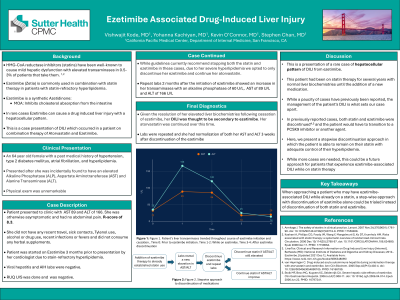Monday Poster Session
Category: Liver
P3028 - Ezetimibe-Associated Drug-Induced Liver Injury
Monday, October 28, 2024
10:30 AM - 4:00 PM ET
Location: Exhibit Hall E

Has Audio

Vishwajit Kode, MD
California Pacific Medical Center
San Francisco, CA
Presenting Author(s)
Vishwajit Kode, MD, Yohanna Khachiyan, MD, Stephen Chan, MD
California Pacific Medical Center, San Francisco, CA
Introduction: Ezetimibe is a synthetic azetidinone that works by inhibiting the Niemann-Pick C1-like 1 protein (NPCI) to prevent the intestinal brush border absorption of cholesterol. It is commonly used as a second line therapy in patients that continue to have hyperlipidemia after the initiation of statin therapy. A rare side effect is the development of a hepatocellular pattern drug induced liver injury (DILI) which has sparse case reports and little direction in management. Here, we report a case of ezetimibe associated DILI and our management approach.
Case Description/Methods: A 64 year old female with hyperlipidemia on rosuvastatin 40mg and ezetimibe, atrial fibrillation on apixaban, hypertension and type two diabetes presented with an aspartate aminotransferase (AST) 89, alanine aminotransferase (ALT) 166, Alkaline phosphatase (ALP) 60 and Total Bilirubin of 0.7. R-factor score was 8.3 indicating a hepatocellular pattern. An abdominal ultrasound was done that showed no evidence of metabolic associated fatty liver disease (MAFLD) and there were no other anatomical defects that could explain the transaminitis. After a detailed history, the patient revealed the only medication change was her recent addition of ezetimibe three months ago for refractory hyperlipidemia. Her hepatitis viral panel was also negative. Based on this, ezetimibe was discontinued but her rosuvastatin was continued. Her transaminitis then resolved on recheck 3 months later, with an AST of 21, ALT 16, ALP 64 and Total bilirubin 0.4. Based on this, it was likely she had a DILI from ezetimibe. In order to manage her hyperlipidemia, the patient was continued on rosuvastatin 40mg with lifestyle modifications and her repeat lipid panel showed an LDL of 64 and total cholesterol of 142. She did not develop any recurrent transaminitis while on her rosuvastatin 40mg dose.
Discussion: Here we present a rare case of hepatocellular pattern of DILI from ezetimibe. While a paucity of cases have previously been reported, the management of the patient’s DILI is what sets our case apart. In previously reported cases, both statin and ezetimibe were discontinued and the patient would have to transition to a PCSK9 inhibitor or another agent. Here, we present a stepwise discontinuation approach in which the patient is able to remain on their statin with adequate control of their hyperlipidemia. While more cases are needed, this could be a future approach to patients that experience ezetimibe associated DILI while on statin therapy.
Disclosures:
Vishwajit Kode, MD, Yohanna Khachiyan, MD, Stephen Chan, MD. P3028 - Ezetimibe-Associated Drug-Induced Liver Injury, ACG 2024 Annual Scientific Meeting Abstracts. Philadelphia, PA: American College of Gastroenterology.
California Pacific Medical Center, San Francisco, CA
Introduction: Ezetimibe is a synthetic azetidinone that works by inhibiting the Niemann-Pick C1-like 1 protein (NPCI) to prevent the intestinal brush border absorption of cholesterol. It is commonly used as a second line therapy in patients that continue to have hyperlipidemia after the initiation of statin therapy. A rare side effect is the development of a hepatocellular pattern drug induced liver injury (DILI) which has sparse case reports and little direction in management. Here, we report a case of ezetimibe associated DILI and our management approach.
Case Description/Methods: A 64 year old female with hyperlipidemia on rosuvastatin 40mg and ezetimibe, atrial fibrillation on apixaban, hypertension and type two diabetes presented with an aspartate aminotransferase (AST) 89, alanine aminotransferase (ALT) 166, Alkaline phosphatase (ALP) 60 and Total Bilirubin of 0.7. R-factor score was 8.3 indicating a hepatocellular pattern. An abdominal ultrasound was done that showed no evidence of metabolic associated fatty liver disease (MAFLD) and there were no other anatomical defects that could explain the transaminitis. After a detailed history, the patient revealed the only medication change was her recent addition of ezetimibe three months ago for refractory hyperlipidemia. Her hepatitis viral panel was also negative. Based on this, ezetimibe was discontinued but her rosuvastatin was continued. Her transaminitis then resolved on recheck 3 months later, with an AST of 21, ALT 16, ALP 64 and Total bilirubin 0.4. Based on this, it was likely she had a DILI from ezetimibe. In order to manage her hyperlipidemia, the patient was continued on rosuvastatin 40mg with lifestyle modifications and her repeat lipid panel showed an LDL of 64 and total cholesterol of 142. She did not develop any recurrent transaminitis while on her rosuvastatin 40mg dose.
Discussion: Here we present a rare case of hepatocellular pattern of DILI from ezetimibe. While a paucity of cases have previously been reported, the management of the patient’s DILI is what sets our case apart. In previously reported cases, both statin and ezetimibe were discontinued and the patient would have to transition to a PCSK9 inhibitor or another agent. Here, we present a stepwise discontinuation approach in which the patient is able to remain on their statin with adequate control of their hyperlipidemia. While more cases are needed, this could be a future approach to patients that experience ezetimibe associated DILI while on statin therapy.
Disclosures:
Vishwajit Kode indicated no relevant financial relationships.
Yohanna Khachiyan indicated no relevant financial relationships.
Stephen Chan indicated no relevant financial relationships.
Vishwajit Kode, MD, Yohanna Khachiyan, MD, Stephen Chan, MD. P3028 - Ezetimibe-Associated Drug-Induced Liver Injury, ACG 2024 Annual Scientific Meeting Abstracts. Philadelphia, PA: American College of Gastroenterology.
